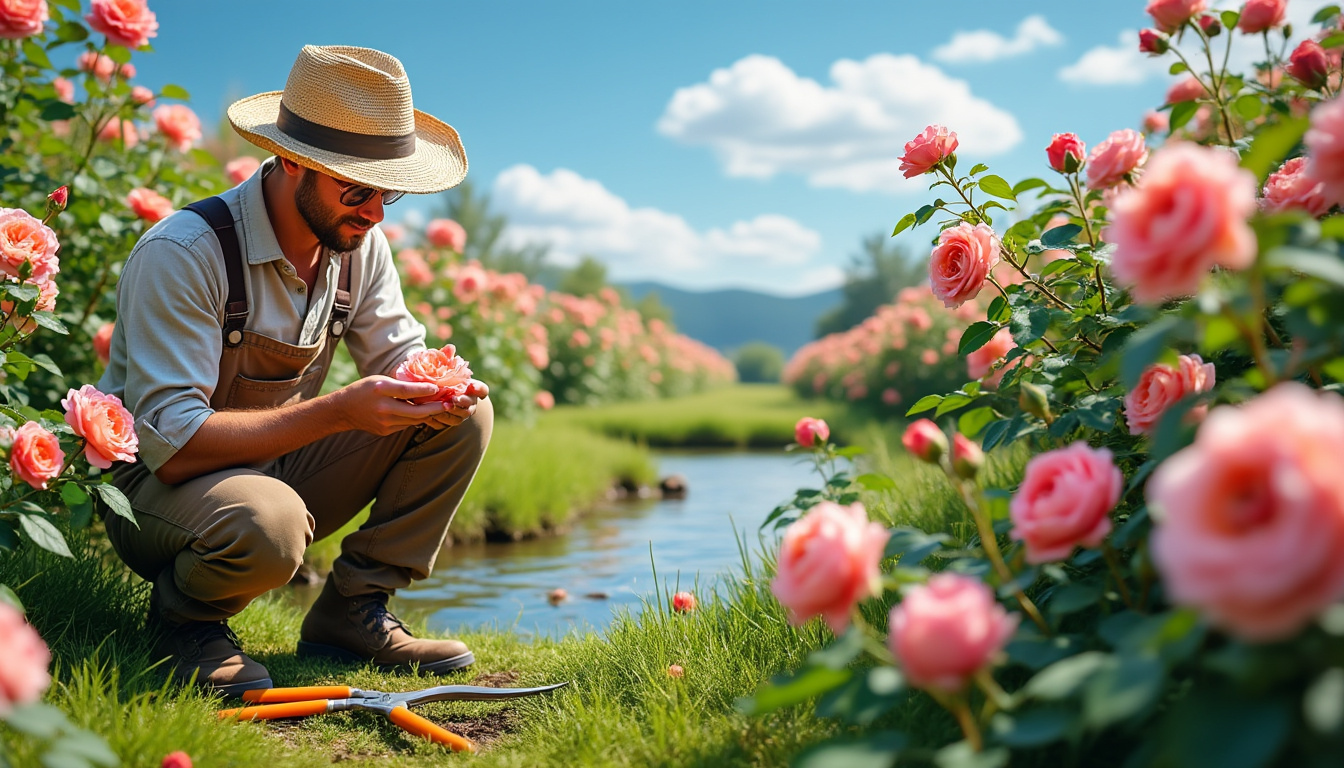Understanding the optimal timing for pruning roses is a crucial aspect of gardening that significantly influences the health and vitality of these beloved plants. The delicate balance between the seasonal cycles and the specific varieties of roses must be taken into account to ensure robust blooms and healthy growth. This article will dive deep into when it is too late to prune roses, the repercussions of improper timing, and practical tips for perfecting the timing of your cuttings.
- Understanding the Importance of Pruning 🌹
- Ideal Pruning Times for Different Rose Varieties 🗓️
- Common Mistakes to Avoid When Pruning 🚫
- Signs It May Be Too Late to Prune ⏰
- Ensuring Roses Thrive After Late Pruning 🌱
Understanding the Importance of Pruning Roses
Pruning is a fundamental aspect of rose care that encourages growth, shapes the bush, and promotes a robust flowering cycle. By trimming the roses at the appropriate times, gardeners can improve their plants’ overall structure and health. Properly executed pruning will lead to enhanced air circulation, reduced pest issues, and the removal of dead or diseased wood, which is essential for fostering a thriving garden environment.
Regular pruning is vital for disease prevention. Dead wood can harbor pests and diseases that affect the overall health of the plant. By actively managing what remains on the shrub, one can ensure a lower chance of infestations and diseases. Moreover, removing stifling branches opens up the center of the bush, allowing sunlight to penetrate and air to circulate, which further reduces disease risk.
Pruning also leads to more vigorous and colorful blooms. As roses often bloom on new growth, efficient pruning stimulates the production of new stems, resulting in bursts of flowers and a lush appearance. The strategic cutting encourages plants to divert energy away from old, less productive wood and focus it on vibrant new growth.
For example, rose enthusiasts have noted that their once-sparse bushes transformed into blooming wonders following systematic pruning. The act of cutting back stems to an outward-facing bud allows for stronger, healthier shoots to emerge while supporting the natural shape of the plant.
In addition, aesthetic benefits arise from shaping roses through proper pruning techniques. A well-pruned rose bush exhibits a healthy silhouette, promoting not just blooms but an overall appealing garden landscape. For beginners or seasoned gardeners, arranging rose bushes into pleasing designs can enhance the overall enjoyment of a garden setting.
The Anatomy of Pruning Techniques
Pruning techniques can vary based on rose types and local climates. Gardeners’ World suggests following specific guidelines to maximize effectiveness:
- Removing Dead Wood: Always start by identifying and cutting away dead or damaged branches.
- Shaping: To maintain an appealing form, thin out crowded areas and shape the bush accordingly.
- Cutting at an Angle: Make cuts at a 45-degree angle above outward-facing buds to encourage outward growth.
- Regular Maintenance: Engage in light pruning throughout the year to address any problems early on.
Utilizing sharp, clean tools will enhance the process and minimize potential contamination. Investing in quality garden tools, like those from Fiskars or Gardena, will ensure effective and clean cuts.
Ideal Pruning Times for Different Rose Varieties
When discussing rose pruning, the timing will greatly depend on the variety of roses cultivated. Recognizing the specific needs of each type will empower gardeners to make informed decisions.
| Rose Type | Ideal Pruning Time | Notes |
|---|---|---|
| Once-Flowering Roses | Immediately after blooming (late spring or early summer) | Pruning too early can remove next year’s buds. |
| Repeat Bloomers | Late winter to early spring | Promotes new growth and continued flowering. |
| Climbing Roses | After blooming cycle ends | Focus should be on removing old canes to stimulate new growth. |
Once-flowering roses bloom solely on old wood. Therefore, pruning them immediately after their blooming cycle is crucial since removing too much can hinder next year’s flowers. Examples of these include Damask and Gallica roses. On the other hand, repeat bloomers such as hybrid teas should be pruned in late winter to early spring, right before new growth starts to emerge, ensuring vibrant flowers throughout the season.
Climbing roses thrive through initial blooming followed by specific pruning. After their flowering phase, a gardener can prune climbing roses to reshape and support new canes, enhancing overall growth and health.
The Role of Climate in Pruning Timing
Local climate significantly influences the timing of rose pruning. Warmer areas may accommodate earlier pruning than cooler regions. For instance, in southern climates of the United States, it is common to begin pruning as early as February. However, in northern regions, more caution is needed, and pruning may not commence until closer to mid-April, ensuring any frost damage is improbable.
When uncertain about the region’s specific timing, consulting local gardening resources, such as the RHS (Royal Horticultural Society), can provide invaluable insights. Gardening organizations can offer tailored advice catering to local growing conditions, enabling gardeners to make proper decisions regarding their pruning schedules based on microclimates.
Common Mistakes to Avoid When Pruning
Even seasoned gardeners may fall into specific traps when it comes to pruning roses. Awareness of common mistakes can help avert setbacks and ensure the health of the plants.
- 🔴 Pruning at the Wrong Time: Pruning too late in the season may remove next year’s blossoms.
- 🔴 Over-Pruning: Cutting back too much can stress the plant and inhibit growth.
- 🔴 Using Dull Tools: Dull shears can damage the plant and introduce pathogens.
- 🔴 Neglecting Cleanliness: Failing to disinfect tools can lead to disease transfer.
Understanding these pitfalls is essential for maintaining a healthy garden. For example, pruning in early fall may tempt gardeners, but it promotes new growth that would be vulnerable during winter frosts. This tip is particularly critical in areas where harsh winters occur. Additionally, managing tools’ cleanliness—perhaps by using products like Espoma’s organic cleaning solutions—ensures that no diseases affect the beautiful roses cared for.
When to plant main crop potatoes for the best yield
Signs It May Be Too Late to Prune
Recognizing the subtle signals indicating that it may be too late to prune roses is essential for maintaining plant vitality. Common signs include:
- 🌱 Buds Starting to Swell: New growth signals that it may be time for new blooms.
- 🌱 Frost Damage Risk: Young shoots are at risk of frost if pruned too late.
- 🌱 Heavily Temped Growth: Overgrown roses can complicate timely pruning.
Observing these signals closely will inform the gardener whether to proceed with pruning or hold until the ideal window opens again. Being proactive with these individual notes ensures that health is preserved, and unnecessary stress is discouraged.
Ensuring Roses Thrive After Late Pruning
Even if pruning is executed later than advised, certain practices can reassure healthy growth. For instance:
- 💧 Deep Watering: Ensuring roses remain hydrated mitigates stress from pruning.
- 💧 Mulch Application: A protective layer can maintain moisture in the soil and protect the roots.
- 💧 Monitor for Damage: Regular inspections for dead or sickly branches allow for timely removal.
Should the timing be missed, adjusting care routines can cushion the blow. Applying a well-balanced fertilizer like Miracle-Gro can promote strong recovery and ease plants into their new growth phase. Following late pruning, enhancing soil health and stimulating growth fosters resilience in rose plants.
Final Care Strategies Post-Pruning
During recovery, ensure that routine care does not fall by the wayside. Attention to the following can enhance rose well-being:
- 🌼 Deadheading: Regularly remove spent blossoms to encourage further blooming.
- 🌼 Consistent Watering: Ensure even moisture, particularly in dryer months.
- 🌼 Soil Testing: Conduct tests to confirm nutrient levels are adequate.
Maintaining diligence throughout the growing season supports optimal health. This vigilant strategy will lead to vibrant blooms that flourish beautifully. Leveraging resources from experts, whether from Costa Farms offerings to Proven Winners selections, can further enhance capability in caring for these stunning plants.
Frequently Asked Questions
When should you not prune roses?
Avoid pruning in late fall or winter, as it can stimulate new growth that is vulnerable to frost.
What happens if you prune too late?
Pruning too late can remove buds for the next season, reducing blooms and risking frost damage to new growth.
How do you prune an old overgrown rose bush?
Cut the bush by one-third, remove dead or damaged wood, and shape it to improve airflow and structure.
What happens to rose bushes if you don’t prune them?
Without pruning, rose bushes can become overgrown, produce fewer blooms, and develop diseases due to poor air circulation.
What should I do if I forgot to prune my roses?
If you forget to prune your shrub rose and it is too late in spring, focus on tidying up by cutting any thin stems or weak growth and removing any dead or damaged stems, leaving healthy green growth intact.















